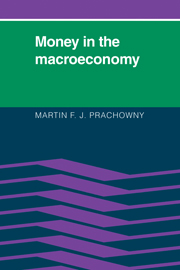Book contents
- Frontmatter
- Contents
- List of charts, figures, and tables
- Preface
- List of symbols
- 1 The roles of money and monetary policy in the macroeconomy
- 2 A model of the macroeconomy
- 3 The new classical model: the case against stabilization policy
- 4 The institutionalist model: the case for stabilization policy
- 5 The demand for money
- 6 The supply of money
- 7 The monetary mechanism
- 8 U.S. monetary policy and the dilemma of stagflation
- 9 A model of an open economy
- 10 Managed exchange rates and monetary policy
- 11 Monetary policy in Canada and its macroeconomic consequences
- 12 Improving the monetary policy apparatus
- Index
2 - A model of the macroeconomy
Published online by Cambridge University Press: 26 October 2011
- Frontmatter
- Contents
- List of charts, figures, and tables
- Preface
- List of symbols
- 1 The roles of money and monetary policy in the macroeconomy
- 2 A model of the macroeconomy
- 3 The new classical model: the case against stabilization policy
- 4 The institutionalist model: the case for stabilization policy
- 5 The demand for money
- 6 The supply of money
- 7 The monetary mechanism
- 8 U.S. monetary policy and the dilemma of stagflation
- 9 A model of an open economy
- 10 Managed exchange rates and monetary policy
- 11 Monetary policy in Canada and its macroeconomic consequences
- 12 Improving the monetary policy apparatus
- Index
Summary
INTRODUCTION
Three “rates” dominate discussions of macroeconomic issues: (1) the inflation rate, (2) the interest rate, and (3) the unemployment rate. In order to understand what can and cannot be done about them it is necessary to have at hand a model of the macroeconomy that can explain movements in these variables. Without the discipline of such a model it is easy to become confused by uninformed opinions and misleading observations. Only with such a model is it possible to comprehend why expanding the money supply is likely to increase the interest rate rather than decrease it, as is often suggested, and why it is virtually impossible to fulfill the politician's promise of “full” employment in a market-oriented economy.
The macroeconomic model to be presented in this chapter is not complicated. In fact, any student who has mastered an intermediate course in macroeconomics has learned the basic ingredients of the model. The IS-LM-AS curves are the only ones that will be used. The basic purpose of the model is to describe in a fairly general way the behavior observed in certain important markets in the economy. In microeconomics we are interested in markets for specific commodities, and the distinction between apples and oranges may be important in that context, but in macroeconomics we take a broader perspective where apples and oranges are just two of many commodities, all lumped together in one aggregate.
- Type
- Chapter
- Information
- Money in the Macroeconomy , pp. 19 - 67Publisher: Cambridge University PressPrint publication year: 1986



